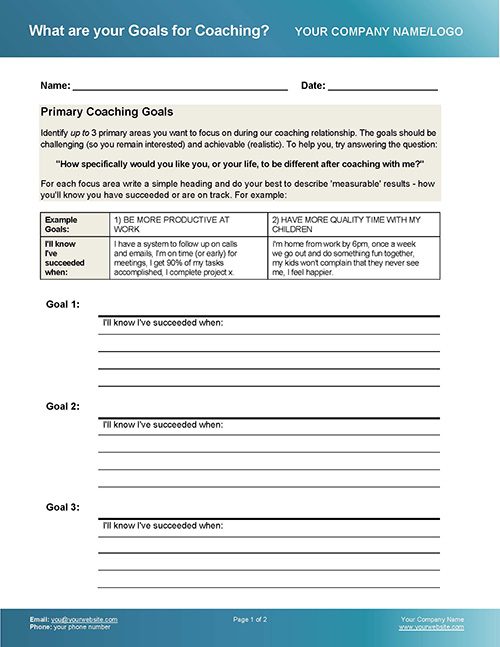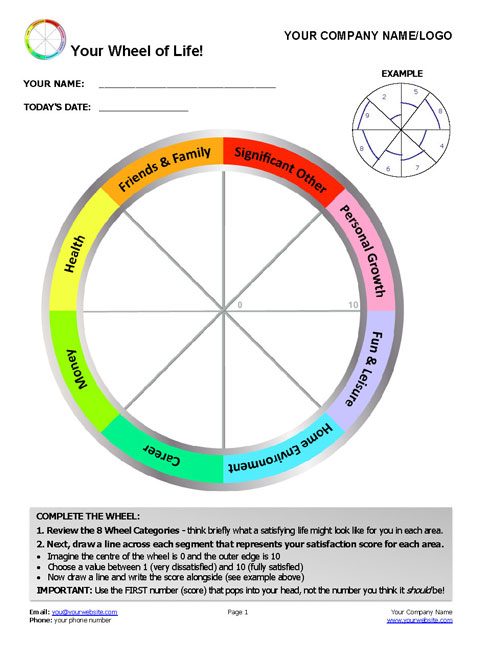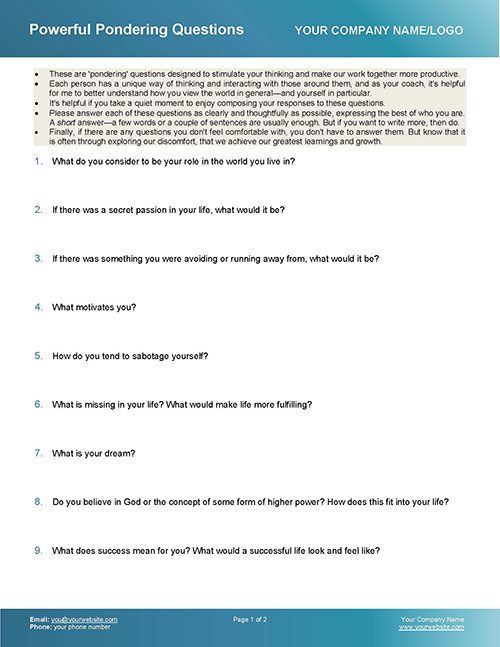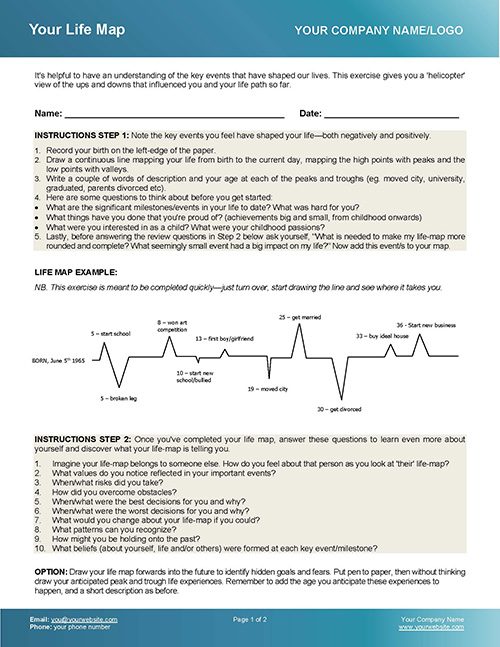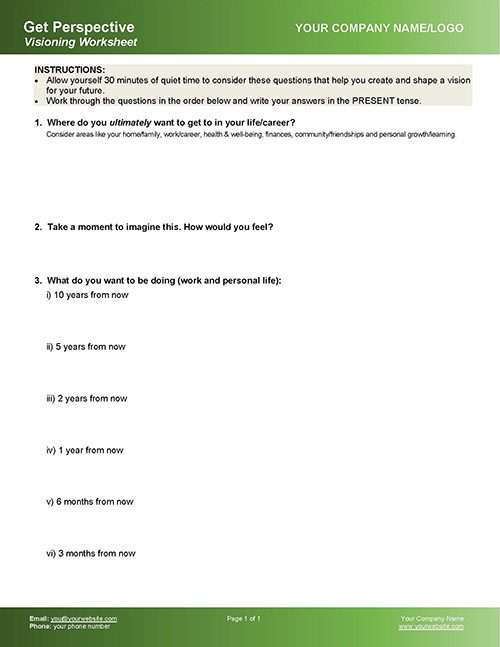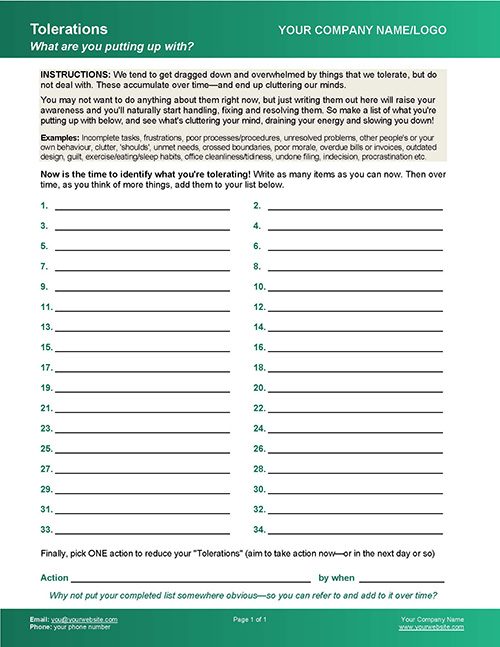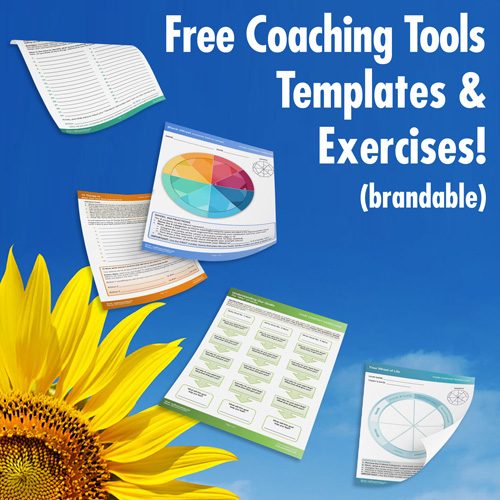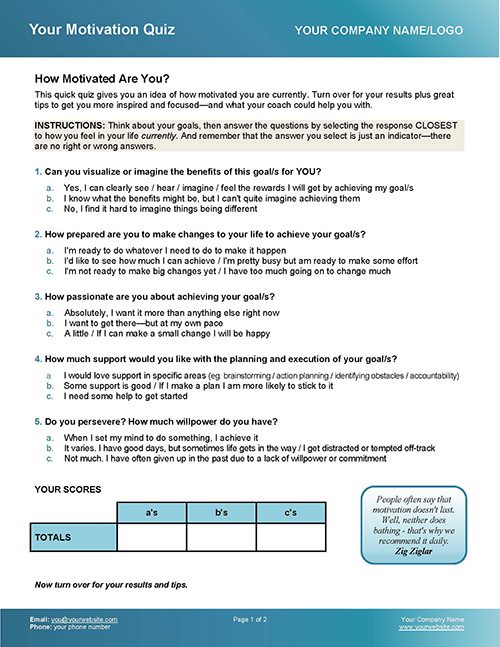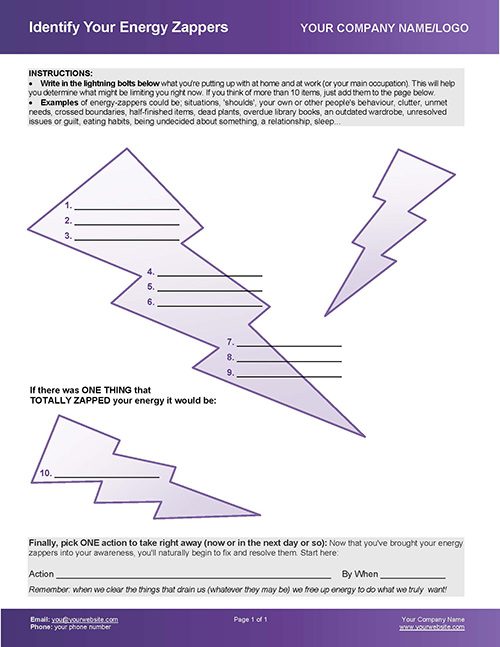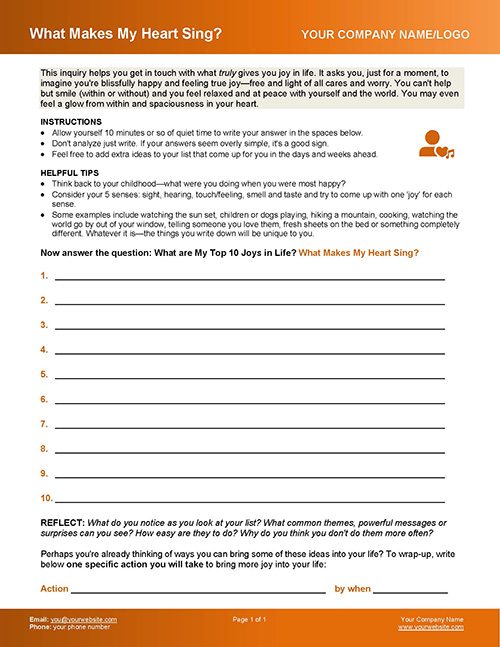Originally Posted on The Coaching Tools Company as The Top 10 Tools for Coaches to use with Brand New Clients (Plus Why and How to Use Them)
I am often asked which are the best tools for coaches. Of course this is an impossible question to answer as every coach and client is different.
However, there are some coaching tools and exercises that are super useful for coaches to use with new clients. And in this article I share my Top 10 Tools for Coaches to use with new clients. You’ll find why the tool is useful, links to each tool, how to use it and some helpful tips too!
New to coaching tools and exercises? Read our Complete Guide to Life Coaching Tools here >>
What’s in this Article
This guide to the top 10 tools for coaches to use with new clients includes the 10 recommended tools and exercises, why they’re great with new clients, how to use them and some top tips to help!
- Coaching Goals Worksheet
- Wheel of Life Template (Free)
- Powerful Pondering Questions
- Life Map Exercise
- Get Perspective Vision Worksheet
- Tolerations: Clear Your Mind Tool (Free)
- Motivation Quiz Tool
- Energy Zappers Coaching Exercise
- What Makes My Heart Sing? Coaching Tool
- 25 Powerful Strengths Questions
- Tools for Coaches Wrap-up and You May Also Like
And we’d also love to hear which are your favourite tools for coaches to use with new clients! So please share your favourites with all the coaches reading this in the comments at the end.
Here are the 10 Best Tools for Coaches to use with New Clients!
Why it’s great with new clients: If I was only allowed to use ONE tool with clients, this tool would be top of the list. As coaches we provide an intangible service, so it’s essential to know what results our clients want. And this tool helps clients get super clear about what they want from working with you.
And if the client doesn’t know what they want, or is vague, this coaching tool helps you get the conversation started! This crucial tool for coaches will highlight gaps in expectations and help you dig deeper into their wants, needs and motivations.
Lastly, this tool becomes a tangible measure for both you and the client. By coaching clients to get crystal clear about outcomes (how they’ll know they’ve achieved their goals), you will both know when the coaching goals are achieved. Success!
How to use with Clients: Give this coaching tool to your clients to complete before your first session with them. Then use part of the first session to coach them around their goals. If they haven’t completed the form, or the responses are too vague, they can finish it as post-session homework. Lastly review this form with your client every 1-3 months to check on progress!
Tip: Review this form before every coaching session. Then if the session starts going off-track, or it looks like the client’s priorities are shifting, revisit the form and ask your client if anything has changed.
2) FREE: The Wheel of Life Template
Why it’s great with new clients: This is one of the few tools for coaches that gives you fantastic overview of how your client is doing across all areas of their life. Which means this is a great diagnostic tool to use with new clients. It’s also fun and a strong visual to show off the power of coaching!
What areas of life could get in the way of their goals? From which areas could they draw strength? And if a client is struggling to set goals—or goals for coaching with you—the Wheel of Life is fabulous to get people started (a client’s low scores suggest areas for them to work on).
Plus, of all the coaching activities out there, the Wheel of Life is endlessly flexible. With a few tweaks to the categories—or using a blank wheel and asking different questions—it can be used in just about any coaching situation.
How to use: I like to include this tool in my Welcome Packet and then review it within our first couple of sessions. It can also be used in workshops, webinars, groups and one-on-one sessions as a quick barometer of how people are doing.
Tip: For everything you need to know on the Wheel of Life, see our Complete Guide to the Wheel of Life for Coaches
And to see how the Wheel can be applied to any situation watch the tools for coaches Wheel of Life Clinic here (video)
Why it’s great with new clients: When clients are new to coaching, they’ve often done little inner reflection. Yes, they may have set goals, but have they thought about what matters most in life? What their passion is? What they’ve been running away from? How they best learn? These powerful questions open up an exciting new world for our clients—and help us get a sense of who they really are.
How to use with Clients: For best results, give this coaching tool to your clients in your Coaching Welcome Packet or prior to your first session. It can also be given any time in the first month. Then review your client’s answers with them. Ask questions like: What did you learn about yourself? What surprised you? Which questions were easiest—and hardest?
Tip: When reviewing your client’s completed form, take them deeper into their answers. They will love you for it, and you will learn how fascinating your client is!
Why it’s great with new clients: This life-mapping tool for coaches asks clients to map out the highs and lows of their life so far. Which life events that impacted them most? This tool gives a fabulous overview and helps us get to know our new client:
- What are the significant milestones and key events that have shaped our clients’ lives?
- What do they see as their achievements? Disappointments?
Overall this is one of our most universally useful tools for coaches and provides great context for the coaching relationship.
How to use: Use in session—or ideally give as homework as part of your coaching welcome packet. Then review the completed life map with clients using the questions supplied (or your own) to delve deeper—and get to know your new client better! This tool can also be used during the coaching engagement to help identify core values, strengths and limiting beliefs.
Tip: Use this coaching tool for self-esteem building. As you review the life map with them, help your clients celebrate what they’ve already achieved and acknowledge the setbacks they’ve overcome…
Why it’s great with new clients: This high level visioning worksheet provides a larger context for our clients’ life, career and coaching goals. It ensures that the goals your clients set while working with you also fit into the big picture (vision) they have for their lives.
Without some kind of vision for our life, we’re easily overwhelmed by choices and options—because anything goes. All too often people let life lead them—simply doing the next thing without considering what they truly want. Then they end up stuck, unhappy or dissatisfied (and seeking a life coach!).
So use this visioning tool early in the coaching relationship to ensure your clients set compelling and meaningful goals. They’ll love you for it.
How to use with Clients: Use within the first couple of coaching sessions or give as homework. This tool is also good in workshops, webinars and groups.
Tip: When reviewing your client’s completed form, take them deeper into their answers. They’ll find this extremely satisfying—and you’ll learn how fascinating your client is!
Why it’s great with new clients: This tool for coaches helps clients identify and release mental and physical clutter so they have energy for what’s really important. This is great to do at the start of a coaching relationship to boost energy. It also helps remove distractions so our clients can focus on making change in their lives.
Empower your clients to make change, ditch what doesn’t serve them and free up some beautiful energy!
How to use: Use in session or give as homework. This tool is also great in workshops, webinars and groups.
Tip: Use this coaching exercise whenever your clients have trouble focusing! Get your clients’ distractions out of their heads and onto paper, so that a plan can be made to reduce and eliminate what’s getting in the way.
Get 30+ Free Tools & Exercises For Coaches!
If you love coaching activities and tools, be sure to check out our Free Coaching Tools & Resources Page. With over 30 tools, templates and forms to add to your coaching toolbox! You’ll find:
- Wheel of Life (Balance Wheel)
- A Blank Wheel of Life (to customise for any situation)
- Understand the Why of Your Goals!
- 25 Questions to Identify Strengths
- Client Action Recording Sheet & Template
- Coaching Intake Session Checklist
- And many more!
We know how hard it is to build a coaching business so we give away these tools free. They’re also brandable and editable—enjoy!
Why it’s great with new clients: Get instant insight into how motivated your clients are! Use this quiz early in a coaching relationship (or even with prospects) to get a feel for how committed and motivated people are. Then use the results to explore why that may be.
This tool for coaches helps you better understand your client’s current motivation levels and adapt your coaching accordingly. Use page 2 for tips to get your new clients more inspired and focused…
How to use with Clients: Use in a coaching session, give as part of a Coaching Welcome Packet or as homework. This tool is also good in workshops, webinars and groups. Lastly, simply ask the questions on the form to gauge how motivated and committed a coaching prospect is.
Tip: You can also use the quiz whenever a client appears to lose motivation, or as a part of your regular goal-setting process.
For more on this helpful tool for coaches, read Our Simple Motivation Quiz Tool – Explained!
Why it’s great with new clients: Achieving our goals is a lot easier when we have energy. In this epidemic of tiredness and overwhelm we live in, energy is a scarce resource. Your new clients will love that you’ve helped them find more oomph to work on their goals with you!
This simple self-care tool helps clients identify energy drains and begin to resolve them. This frees up energy for them to take action and create a life they love. Which means it also showcases the power of coaching to stop, look and listen to ourselves, then make change!
How to use: Use in session or give as homework. This tool is also great in workshops, webinars and groups. I love to review the completed form with clients and come up with 1-3 actions.
Tip: I often return to this form as a check-in for how clients may be feeling, and what could be slowing them down. This exercise can also be a great introduction (for clients who need it!) to the idea that our mental health impacts our energy too…
Why it’s great with new clients: Many people look for happiness in pleasurable activities or material goods without realizing that joy is on their doorstep—and often costs nothing! This coaching tool demonstrates the power of coaching to see our lives in a new, happier way.
Help your clients create a more joyous and genuine self-connection through understanding what makes their “heart sing”. They’ll find more happiness—where they are, and attribute that to the power of (your) coaching.
How to use with Clients: This coaching exercise is one of my personal favourites. I have used this tool extensively as homework, in one-on-one sessions and as a powerful group exercise in webinars and workshops.
Tip: Also consider using this tool when your clients have had a setback or feel stuck. It’s a great reminder that the small things in life are what truly make us happy—and that these are always available to us.
For more on this popular tool for coaches, see:
- Tools Clinic (video with demo of how to use the tool): What Makes My Heart Sing Exercise
- Coaching Tools 101: How to Create More Joy in Life with the What Makes My Heart Sing? Exercise
Why it’s great with new clients: Many people find it easy to reel off their faults, but stumble when asked to identify their strengths. We can use this tool to give our new clients a self-esteem-boost!
When clients come to coaching they’re often unsure of what to expect. Helping clients brainstorm their strengths with them is easy, fun—and uplifting. And it’s also a great way for us to learn more about our new client: How confident are they? How well do they know themselves? What transferable skills and strengths to draw on when working towards their goals?
How to use: Use this tool in a one-on-one “strengths identification” coaching session, as a workshop handout or give as homework.
You can also use sections of questions in a webinar or group. Simply give a set of questions and put people into groups or a breakout room to help each other brainstorm answers and come back with a list!
Tips:
- Once you have a list of strengths, draw on these in future coaching sessions to overcome obstacles or complete a difficult task.
- When asking these strengths questions, go into the detail. Look for things your client might normally gloss over—and drill down to specific examples.
- If a question response is not a strength, ask your client, “What’s special about that?” until you get to the strength underneath.
- I also love to follow strengths identification with the Boost Your Strengths Tool.
Wrap-up: Tools for Coaches to use with New Clients
So, what did you think of the tools for coaches we recommended?
I really struggled to choose just 10 tools! But these are the 10 most helpful, uplifting, universal and powerful tools I can think of to use with new clients.
And if you have any suggestions of your own for tools to use with new clients, please share with readers by adding a comment below.
You may also like these articles with even more tools for coaches:
- How I got 12 New Clients by Creating a Coaching Program (and why it was a turning point!)
- Virginia Satir’s 6 Stages of Change & What it Means for Coaches! (helpful to understand for new clients!)
- 7 Career Coaching Tools and Ideas For Clients Who Have Absolutely No Idea What They Want!
- 5 Coaching Tools to Boost Authenticity (with examples)
Plus check out our Complete Guide to Coaching Tools here >>
Love Coaching Questions and Tools?
Get 549 powerful coaching questions (and 4 more monthly free tools) as your gift with newsletter sign-up!
window.cfields = [];
window._show_thank_you = function(id, message, trackcmp_url, email) {
var form = document.getElementById(‘_form_’ + id + ‘_’), thank_you = form.querySelector(‘._form-thank-you’);
form.querySelector(‘._form-content’).style.display = ‘none’;
thank_you.innerHTML = message;
thank_you.style.display = ‘block’;
const vgoAlias = typeof visitorGlobalObjectAlias === ‘undefined’ ? ‘vgo’ : visitorGlobalObjectAlias;
var visitorObject = window[vgoAlias];
if (email && typeof visitorObject !== ‘undefined’) {
visitorObject(‘setEmail’, email);
visitorObject(‘update’);
} else if (typeof(trackcmp_url) != ‘undefined’ && trackcmp_url) {
// Site tracking URL to use after inline form submission.
_load_script(trackcmp_url);
}
if (typeof window._form_callback !== ‘undefined’) window._form_callback(id);
};
window._show_error = function(id, message, html) {
var form = document.getElementById(‘_form_’ + id + ‘_’), err = document.createElement(‘div’), button = form.querySelector(‘button’), old_error = form.querySelector(‘._form_error’);
if (old_error) old_error.parentNode.removeChild(old_error);
err.innerHTML = message;
err.className = ‘_error-inner _form_error _no_arrow’;
var wrapper = document.createElement(‘div’);
wrapper.className = ‘_form-inner’;
wrapper.appendChild(err);
button.parentNode.insertBefore(wrapper, button);
document.querySelector(‘[id^=”_form”][id$=”_submit”]’).disabled = false;
if (html) {
var div = document.createElement(‘div’);
div.className = ‘_error-html’;
div.innerHTML = html;
err.appendChild(div);
}
};
window._load_script = function(url, callback) {
var head = document.querySelector(‘head’), script = document.createElement(‘script’), r = false;
script.type = ‘text/javascript’;
script.charset = ‘utf-8’;
script.src = url;
if (callback) {
script.onload = script.onreadystatechange = function() {
if (!r && (!this.readyState || this.readyState == ‘complete’)) {
r = true;
callback();
}
};
}
head.appendChild(script);
};
(function() {
if (window.location.search.search(“excludeform”) !== -1) return false;
var getCookie = function(name) {
var match = document.cookie.match(new RegExp(‘(^|; )’ + name + ‘=([^;]+)’));
return match ? match[2] : null;
}
var setCookie = function(name, value) {
var now = new Date();
var time = now.getTime();
var expireTime = time + 1000 * 60 * 60 * 24 * 365;
now.setTime(expireTime);
document.cookie = name + ‘=’ + value + ‘; expires=’ + now + ‘;path=/; Secure; SameSite=Lax;’;// cannot be HttpOnly
}
var addEvent = function(element, event, func) {
if (element.addEventListener) {
element.addEventListener(event, func);
} else {
var oldFunc = element[‘on’ + event];
element[‘on’ + event] = function() {
oldFunc.apply(this, arguments);
func.apply(this, arguments);
};
}
}
var _removed = false;
var form_to_submit = document.getElementById(‘_form_28_’);
var allInputs = form_to_submit.querySelectorAll(‘input, select, textarea’), tooltips = [], submitted = false;
var getUrlParam = function(name) {
var params = new URLSearchParams(window.location.search);
return params.get(name) || false;
};
for (var i = 0; i < allInputs.length; i++) {
var regexStr = "field[(d+)]";
var results = new RegExp(regexStr).exec(allInputs[i].name);
if (results != undefined) {
allInputs[i].dataset.name = window.cfields[results[1]];
} else {
allInputs[i].dataset.name = allInputs[i].name;
}
var fieldVal = getUrlParam(allInputs[i].dataset.name);
if (fieldVal) {
if (allInputs[i].dataset.autofill === "false") {
continue;
}
if (allInputs[i].type == "radio" || allInputs[i].type == "checkbox") {
if (allInputs[i].value == fieldVal) {
allInputs[i].checked = true;
}
} else {
allInputs[i].value = fieldVal;
}
}
}
var remove_tooltips = function() {
for (var i = 0; i < tooltips.length; i++) {
tooltips[i].tip.parentNode.removeChild(tooltips[i].tip);
}
tooltips = [];
};
var remove_tooltip = function(elem) {
for (var i = 0; i < tooltips.length; i++) {
if (tooltips[i].elem === elem) {
tooltips[i].tip.parentNode.removeChild(tooltips[i].tip);
tooltips.splice(i, 1);
return;
}
}
};
var create_tooltip = function(elem, text) {
var tooltip = document.createElement('div'), arrow = document.createElement('div'), inner = document.createElement('div'), new_tooltip = {};
if (elem.type != 'radio' && elem.type != 'checkbox') {
tooltip.className = '_error';
arrow.className = '_error-arrow';
inner.className = '_error-inner';
inner.innerHTML = text;
tooltip.appendChild(arrow);
tooltip.appendChild(inner);
elem.parentNode.appendChild(tooltip);
} else {
tooltip.className = '_error-inner _no_arrow';
tooltip.innerHTML = text;
elem.parentNode.insertBefore(tooltip, elem);
new_tooltip.no_arrow = true;
}
new_tooltip.tip = tooltip;
new_tooltip.elem = elem;
tooltips.push(new_tooltip);
return new_tooltip;
};
var resize_tooltip = function(tooltip) {
var rect = tooltip.elem.getBoundingClientRect();
var doc = document.documentElement, scrollPosition = rect.top – ((window.pageYOffset || doc.scrollTop) – (doc.clientTop || 0));
if (scrollPosition < 40) {
tooltip.tip.className = tooltip.tip.className.replace(/ ?(_above|_below) ?/g, '') + ' _below';
} else {
tooltip.tip.className = tooltip.tip.className.replace(/ ?(_above|_below) ?/g, '') + ' _above';
}
};
var resize_tooltips = function() {
if (_removed) return;
for (var i = 0; i < tooltips.length; i++) {
if (!tooltips[i].no_arrow) resize_tooltip(tooltips[i]);
}
};
var validate_field = function(elem, remove) {
var tooltip = null, value = elem.value, no_error = true;
remove ? remove_tooltip(elem) : false;
if (elem.type != 'checkbox') elem.className = elem.className.replace(/ ?_has_error ?/g, '');
if (elem.getAttribute('required') !== null) {
if (elem.type == 'radio' || (elem.type == 'checkbox' && /any/.test(elem.className))) {
var elems = form_to_submit.elements[elem.name];
if (!(elems instanceof NodeList || elems instanceof HTMLCollection) || elems.length <= 1) {
no_error = elem.checked;
}
else {
no_error = false;
for (var i = 0; i < elems.length; i++) {
if (elems[i].checked) no_error = true;
}
}
if (!no_error) {
tooltip = create_tooltip(elem, "Please select an option.");
}
} else if (elem.type =='checkbox') {
var elems = form_to_submit.elements[elem.name], found = false, err = [];
no_error = true;
for (var i = 0; i < elems.length; i++) {
if (elems[i].getAttribute('required') === null) continue;
if (!found && elems[i] !== elem) return true;
found = true;
elems[i].className = elems[i].className.replace(/ ?_has_error ?/g, '');
if (!elems[i].checked) {
no_error = false;
elems[i].className = elems[i].className + ' _has_error';
err.push("Checking %s is required".replace("%s", elems[i].value));
}
}
if (!no_error) {
tooltip = create_tooltip(elem, err.join('
‘));
}
} else if (elem.tagName == ‘SELECT’) {
var selected = true;
if (elem.multiple) {
selected = false;
for (var i = 0; i < elem.options.length; i++) {
if (elem.options[i].selected) {
selected = true;
break;
}
}
} else {
for (var i = 0; i < elem.options.length; i++) {
if (elem.options[i].selected && (!elem.options[i].value || (elem.options[i].value.match(/n/g)))) {
selected = false;
}
}
}
if (!selected) {
elem.className = elem.className + ' _has_error';
no_error = false;
tooltip = create_tooltip(elem, "Please select an option.");
}
} else if (value === undefined || value === null || value === '') {
elem.className = elem.className + ' _has_error';
no_error = false;
tooltip = create_tooltip(elem, "This field is required.");
}
}
if (no_error && (elem.id == 'field[]' || elem.id == 'ca[11][v]')) {
if (elem.className.includes('phone-input-error')) {
elem.className = elem.className + ' _has_error';
no_error = false;
}
}
if (no_error && elem.name == 'email') {
if (!value.match(/^[+_a-z0-9-'&=]+(.[+_a-z0-9-']+)*@[a-z0-9-]+(.[a-z0-9-]+)*(.[a-z]{2,})$/i)) {
elem.className = elem.className + ' _has_error';
no_error = false;
tooltip = create_tooltip(elem, "Enter a valid email address.");
}
}
if (no_error && /date_field/.test(elem.className)) {
if (!value.match(/^dddd-dd-dd$/)) {
elem.className = elem.className + ' _has_error';
no_error = false;
tooltip = create_tooltip(elem, "Enter a valid date.");
}
}
tooltip ? resize_tooltip(tooltip) : false;
return no_error;
};
var needs_validate = function(el) {
if(el.getAttribute('required') !== null){
return true
}
if(el.name === 'email' && el.value !== ""){
return true
}
if((el.id == 'field[]' || el.id == 'ca[11][v]') && el.className.includes('phone-input-error')){
return true
}
return false
};
var validate_form = function(e) {
var err = form_to_submit.querySelector('._form_error'), no_error = true;
if (!submitted) {
submitted = true;
for (var i = 0, len = allInputs.length; i < len; i++) {
var input = allInputs[i];
if (needs_validate(input)) {
if (input.type == 'tel') {
addEvent(input, 'blur', function() {
this.value = this.value.trim();
validate_field(this, true);
});
}
if (input.type == 'text' || input.type == 'number' || input.type == 'time') {
addEvent(input, 'blur', function() {
this.value = this.value.trim();
validate_field(this, true);
});
addEvent(input, 'input', function() {
validate_field(this, true);
});
} else if (input.type == 'radio' || input.type == 'checkbox') {
(function(el) {
var radios = form_to_submit.elements[el.name];
for (var i = 0; i < radios.length; i++) {
addEvent(radios[i], 'click', function() {
validate_field(el, true);
});
}
})(input);
} else if (input.tagName == 'SELECT') {
addEvent(input, 'change', function() {
validate_field(this, true);
});
} else if (input.type == 'textarea'){
addEvent(input, 'input', function() {
validate_field(this, true);
});
}
}
}
}
remove_tooltips();
for (var i = 0, len = allInputs.length; i 31 && (charCode 57) && charCode !== 8) {
e.preventDefault();
}
});
};
var showPhoneInputError = function(inputId) {
var errorMessage = document.getElementById(“error-msg-” + inputId);
var input = document.getElementById(inputId);
errorMessage.classList.add(“phone-error”);
errorMessage.classList.remove(“phone-error-hidden”);
input.classList.add(“phone-input-error”);
};
var _form_serialize = function(form){if(!form||form.nodeName!==”FORM”){return }var i,j,q=[];for(i=0;i<form.elements.length;i++){if(form.elements[i].name===""){continue}switch(form.elements[i].nodeName){case"INPUT":switch(form.elements[i].type){case"tel":q.push(form.elements[i].name+"="+encodeURIComponent(form.elements[i].previousSibling.querySelector('div.iti__selected-dial-code').innerText)+encodeURIComponent(" ")+encodeURIComponent(form.elements[i].value));break;case"text":case"number":case"date":case"time":case"hidden":case"password":case"button":case"reset":case"submit":q.push(form.elements[i].name+"="+encodeURIComponent(form.elements[i].value));break;case"checkbox":case"radio":if(form.elements[i].checked){q.push(form.elements[i].name+"="+encodeURIComponent(form.elements[i].value))}break;case"file":break}break;case"TEXTAREA":q.push(form.elements[i].name+"="+encodeURIComponent(form.elements[i].value));break;case"SELECT":switch(form.elements[i].type){case"select-one":q.push(form.elements[i].name+"="+encodeURIComponent(form.elements[i].value));break;case"select-multiple":for(j=0;j<form.elements[i].options.length;j++){if(form.elements[i].options[j].selected){q.push(form.elements[i].name+"="+encodeURIComponent(form.elements[i].options[j].value))}}break}break;case"BUTTON":switch(form.elements[i].type){case"reset":case"submit":case"button":q.push(form.elements[i].name+"="+encodeURIComponent(form.elements[i].value));break}break}}return q.join("&")};
var form_submit = function(e) {
e.preventDefault();
if (validate_form()) {
// use this trick to get the submit button & disable it using plain javascript
document.querySelector('#_form_28_submit').disabled = true;
var serialized = _form_serialize(document.getElementById('_form_28_')).replace(/%0A/g, 'n');
var err = form_to_submit.querySelector('._form_error');
err ? err.parentNode.removeChild(err) : false;
_load_script('//newsletter.thecoachingtoolscompany.com/proc.php?' + serialized + '&jsonp=true');
}
return false;
};
addEvent(form_to_submit, 'submit', form_submit);
})();
Join our popular weekly newsletter to get your gift plus 4 more monthly free coaching tools.



